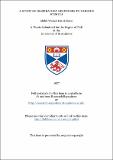A study of respiratory responses to various stimuli
Abstract
In normal subjects, the ventilatory and mouth occlusion pressure (both total mouth occlusion at 0.1 sec. from beginning of inspiration (P0.1) and the maximum rate of change of mouth occlusion pressure, (dp/dt)max.,) responses to CO2 was studied. All three responses gave similar results. However, the P0.1 response has the dis-advantage that subjects anticipated and were conscious of the occlusion; thus it was not used further. In hypoxia tests too, (dp/dt)max. and ventilatory responses gave similar results. With added airways obstruction, the ventilatory response to CO2 was significantly reduced whereas the (dp/dt) max. response was unaffected, suggesting that (dp/dt) max. reflects the respiratory centre output. In patients with chronic airways obstruction, the normocapnic group showed a significantly lower ventilatory response to CO2 but the (dp/dt) max. response was in the range of the normal subjects in 87% of the patients. The hypercapnic patients showed significantly lower ventilatory and (dp/dt) max. responses to CO2 when compared to that of the normal subjects. The resting PaCO2 showed a better correlation with (dp/dt) max. response than with ventilatory response. The ventilatory response in the patients showed a significant correlation with the degree of airways obstruction whilst (dp/dt) max. response did not show any such relationship. This suggests that (dp/dt) max. may be a reliable index of respiratory centre output independent of airways obstruction. In anaesthetized rabbits, ventilation, (dp/dt) max. and the average rate and total diaphragmatic electrical activity (integrated EMG) in response to CO2 was compared. In unobstructed breathing, all four responses gave similar results. With added airways obstruction, the ventilatory response was significantly reduced whilst the other three responses were unaffected. Changes in (dp/dt) max. paralled changes in EMG activity with increases in PCO2. Thus it is shown again that (dp/dt) max. is independent of airways obstruction, and can be said to reflect the respiratory centre neural output. In 47 normal subjects, the ventilatory response to exercise (when exercise is expressed as CO2 produced and O2 uptake) was studied in trained and untrained subjects. The exercise ventilatory response was compared to the CO2 response as measured by ventilation and in some subjects by (dp/dt) max. response. It is found that trained subjects had a significantly lower CO2 response and a lower ventilatory response to exercise than the untrained. The ventilatory and (dp/dt) max. responses correlated significantly with exercise ventilatory response. A similar correlation was found between (dp/dt) max. and ventilatory response to hypoxia and exercise ventilatory response. The breathing pattern of man was also studied to find its relationship with the above findings.
Type
Thesis, PhD Doctor of Philosophy
Collections
Items in the St Andrews Research Repository are protected by copyright, with all rights reserved, unless otherwise indicated.

